The post the Ultimate Clothing Guide for Full-Time RV Life first appeared on Old South Paw.
]]>Instead of collecting poorly made shirts from Forever 21 and Shein, I now have only a few key pieces that I research and invest in that make sense for my lifestyle and comfort, year round.
If you’re moving into an RV, about to take a cross-country trip or just want to start from scratch on a practical wardrobe, here’s some advice on how to get started.

FabricS
Fabrics are one of the most important things to consider in your wardrobe. Living in an RV, you may have less opportunity to wash your clothes, or you may choose to wash them by hand. With this in mind, you need to choose fabrics that don’t absorb smells and dry quickly.
The best fabrics to look for when living in an RV are synthetic fibers, like polyester or nylon. I also recommend merino wool for items like socks and sweaters. These fabrics will dry quickly and won’t absorb moisture, which is ideal for RV living.
THE KEY PIECES
To start your wardrobe, you need a few foundational pieces to build off of. Below are descriptions of my wardrobe pieces and how many I have of each.
Here is a list of clothes I keep with me, but keep in mind that not every piece here is a one-size-fits-all for every RV-lifer.
- Two Tank tops/Undershirts: Nylon or polyester. Pick tank tops with neutral colors that you can easily pair with other clothes. Make sure the tank top straps match the style of your bra straps.
- Three Short Sleeve Shirts: Nylon or polyester. Pick thick, durable fabrics. Avoid pieces with excessive accents, beads or graphics. Keep it neutral in style and color.
- Two Long Sleeve Shirts: Nylon, polyester or merino wool. Thermal shirts and UV protective fabrics are great to have in your arsenal.
- One Cover-Up/Button Up Shirt: Nylon, polyester or synthetic blend. Great for layering, I keep a thin button-up top with me which I can easily put on or tie around my waist depending on the weather.
- Two Pairs of Shorts: Nylon, polyester, or nylon-spandex mix. Make sure that the length is comfortable and practical for long car trips.
- Two Pairs of Pants: Nylon, polyester, or nylon-spandex mix. Play with your preferences here; leggings, cargo pants and hiking pants are all great options. Avoid denim material.
- Ten Pairs of Underwear: Polyester. Avoid uncomfortable pieces or intricate lingerie. Stick with bikini or boy short styles (or whatever is most comfortable for you; but always pick comfort).
- Three Bras: Polyester. Pick an appropriate level of support for physical activity with simple designs. Avoid underwire; comfort is key. Stick with neutral colors. I recommend having black, skin tone and white colors in your arsenal.
- Six Pairs of Socks: Merino wool keeps your feet cool and dry like no other material. Stick with ankle height socks; they’re the most versatile.
- Two Pairs of Shoes: Keep a hiking or work boot and a casual sandal in your closet. For the sandals, choose a pair that go on quickly in the car, but have ankle support if you need to run.
EXTRA PIECES
Depending on the climate you stay in and activities you engage in, the pieces you add on to your wardrobe may look very different from mine. We tend to stick to living in warmer climates, so if you’re planning a trip in Alaska anytime soon, this part is probably not for you! With that in mind, here are some small pieces I’ve added on to my wardrobe and why I have them.
- Bandana: I use a bandana regularly to keep my layered hair back from my face. In a bad situation, it can also be used as a tourniquet.
- Swimsuit: Since a lot of our camping is done in Florida, I keep a swimsuit with me for impromptu beach visits.
- Rain Poncho: In case of unpredictable weather, a rain poncho is a portable option that doesn’t take up a lot of backpack space.
- Trucker Hat: It keeps the heat off my face, but it’s also a fun accessory.
- Winter Shell or Pullover: We don’t often camp in freezing areas, but we do sometimes experience the range of 20° – 30° weather. When this strikes, I like to have a thick layer to put on top of my basics. I recommend fleece or merino wool.
- One Nice Dress: I keep one versatile, semi-formal dress with me at all times. Even though our life is pretty rugged, you never know when a wedding, funeral or other formal event may pop up!
BRANDS
Sustainable, durable clothing is a worthy investment when you have a limited wardrobe. Once upon a time, I only hunted on the clearance racks. Now, I would much rather pay a bit more for a high quality piece that I don’t have to replace again in a few months. I’ve learned the hard way that buying cheap always comes back to bite you when it falls apart later. The added bonus is that if you’re willing to pay a bit more, you can also support ethical and sustainable businesses while you do it.
By minimizing your wardrobe to a few high quality pieces, you’ll almost never have to shop for new clothes, and ultimately save more money. Here are some brands I recommend that make long-lasting, sustainable clothing options for your RV life. This post is not sponsored.
Teva
Teva makes versatile sport sandals made from recycled materials. Their sandals are a great option for a quick-go, comfortable and sporty shoe that will last a long time. They also come in a lot of great colors and styles to choose from!
REI
In addition to selling some great sustainable and long lasting brands, REI has its own line of clothing with RV-friendly fabric options, including some recycled fabrics. If you are on a budget, they’re a great mid-grade price option without compromising quality.
Patagonia
A great option for your winter shell, Patagonia makes durable and versatile clothing. They use low-impact materials and pay living wages to their workers. On their website, they even sell their own secondhand clothes at a discounted price!
Smartwool
As long as Smartwool exists, I will never look for a different brand of socks. At the risk of sounding very weird, I cannot stress how much I love these socks. (Again, this post isn’t sponsored…but I wish!) These socks are comfortable, extremely durable and one pair can last you for years. They’re a great choice for summer or winter. They also use some recycled materials in their products.
Do’s and Dont’s
To summarize what we’ve covered, here are some basic do’s and don’ts for your RV life wardrobe.
Don’t: Wear cotton or denim. Cotton and denim absorb sweat and moisture, which is not friendly towards the labor-intensive lifestyle of living in an RV!
Don’t: Pick clothes that are a part of a passing trend. No one wants to drop good money on a piece that you’ll wind up embarrassed to wear in a couple of months!
Don’t: Pick impractical pieces. Avoid pants and shorts without pockets or with difficult buttons that you’ll fight to put on.
Don’t: Pick bulky clothes that won’t dry out and are hard to pack. With minimal space, you need to keep how large your clothing pieces are in mind for ease of packing.
Don’t: Buy clothes that don’t match and coordinate with each other.
Don’t: Buy clothes that are poorly made. Please take my word for it; it really is a worthy investment!
Do: Wear synthetic materials like nylon or polyester to keep you smelling fresh between laundry days.
Do: Stick with classic pieces and colors that are tried and true.
Do: Ensure that you’re comfortable in all of your clothing. Clothes should fit you well and feel great on your skin.
Do: Wear clothes that are lightweight, easy to layer and don’t take up too much space.
Do: Purchase clothes that have variety, but that can all mix-and-match well together.
Do: Invest in a few high-quality pieces that can withstand your lifestyle.
Do: Make sure that whatever pieces you choose to buy, they are 100%, unapologetically you!
What clothing pieces are a must for your RV life? Let me know in the comments below!

The post the Ultimate Clothing Guide for Full-Time RV Life first appeared on Old South Paw.
]]>The post 5 Essentials for Living Off-Grid in a Scamp Trailer first appeared on Old South Paw.
]]>As soon as we started off-grid living in our 13ft Scamp Trailer full-time, we quickly realized that
there were a lot of things people said that we needed, but we never ended up using them!
Living in our Scamp, there are only a few things we truly couldn’t maintain our lifestyle without.
If you’re considering living in a Scamp trailer or any other tiny camper, here are five essential items we highly recommend purchasing, how we use them, and why. I’ve also included our favorite and least favorite things about each product to help you decide if it’s right for you.
The Essentials
BPA Free Collapsible Water Storage Carriers with Spigot
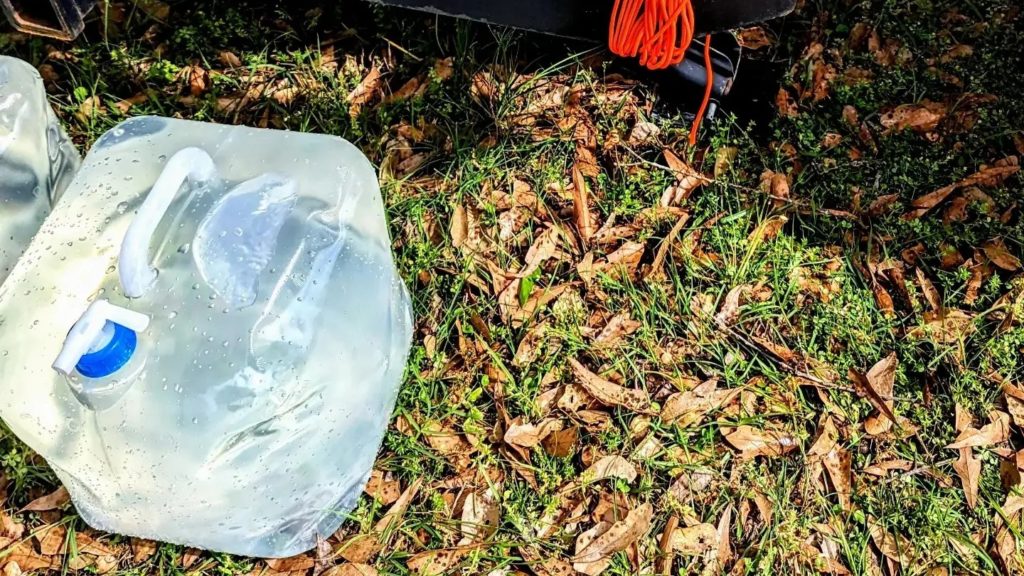
Our collapsible water jugs are a life-saver. Living off-grid, we regularly camp at locations without a water spigot available. Being a collapsible water jug, they minimize space. They’re 5.3 gallons each, which isn’t too heavy for me to carry when they’re filled. Four water jugs lasts us about two days off-grid without refilling (two people drinking, taking navy showers and washing dishes 2x a day).
PROS:
- Collapsible/space saving
- BPA free
- Not too heavy (filled or unfilled)
- Easy to refill
CONS:
- You may need to purchase several depending on how long you intend to off-grid at a time
- May not be easy to clean after years of use due to the small opening
- May puncture easily (ours haven’t yet)
You can purchase these water jugs through Amazon here.
Moisture Absorber Boxes
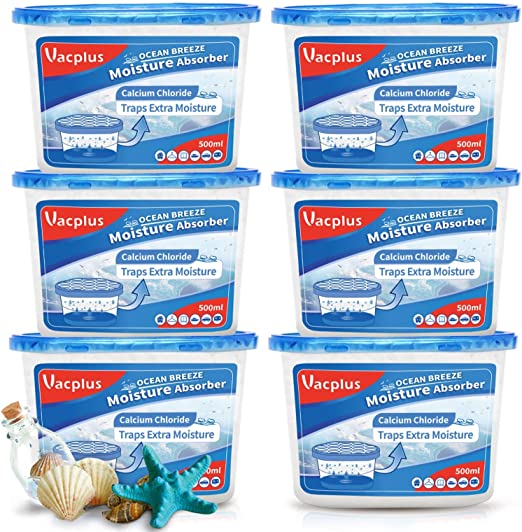
Our Moisture Absorber Boxes aren’t a particularly sexy product, but if you live in an area with any humidity at all, it’s a non-negotiable for living in a camper. Our very first month in our Scamp, our linens we kept in our small cabinet were quickly riddled with mildew and I knew we needed a simple solution, fast. These boxes are economical and get the job done. This particular set of 6 was just the amount we needed for our cabinets.
Pros:
- Compact/fits in all cabinets without using up much space
- Simple to use (by comparison to electric dehumidifiers)
- No electricity required
- No leakage (I’ve never seen it drip, not even in transit)
- Economical
- Leave it and forget about it
- Scent isn’t noticeable (maybe a con, depending on how you feel about scents!)
Cons:
- Not aesthetically pleasing (I keep one on our floor; it’s not the prettiest)
- Expect to repurchase every 3-6 months (depending on humidity levels; we’re primarily in Florida)
- Probably not advisable to keep around animals or small children
You can purchase these moisture absorbers through Amazon here.
Camco Rhino 15-Gallon Portable RV Tote Tank
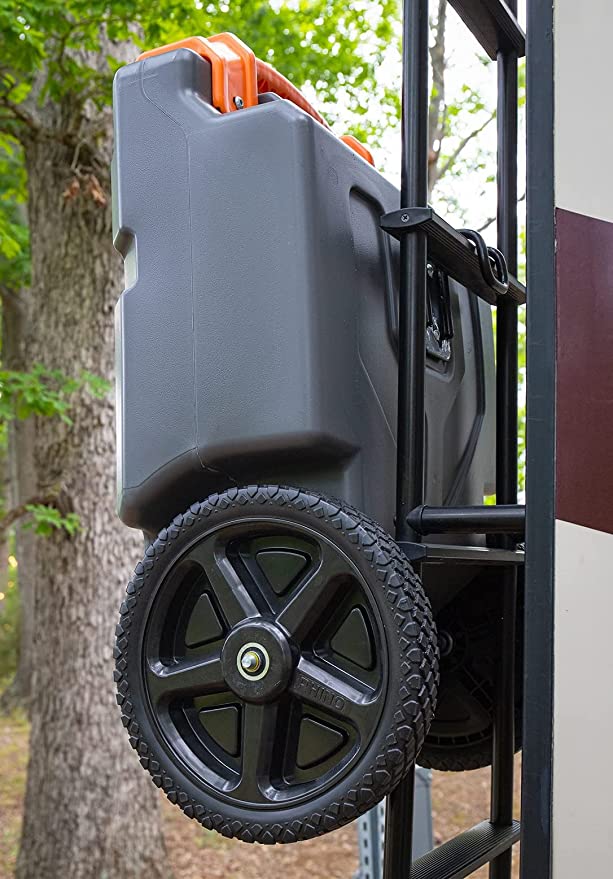
If you’re planning on living off-grid in your tiny camper, one thing you must confront is how you plan on dealing with your “dirty deeds”. If you have a built-in bathroom and plan to live off-grid like we do, don’t expect to have sewage readily available everywhere for you to dump your black and gray water tanks. This portable rolling tank allows you to empty your camper and cart the tank to the nearest dumpsite by hand, truck bed or vehicle hitch.
Pros:
- Extremely tough and durable body
- Multiple options for transporting (includes tow adapter)
- Includes everything you need (hose, elbow and all)
- Easy to use
- Easy to keep clean
Cons:
- Hose is somewhat flimsy in comparison to the rest
- Extremely heavy when full (my husband and I both have to lift it)
You can purchase this rolling tank through Amazon here.
Propane Tank Gauges
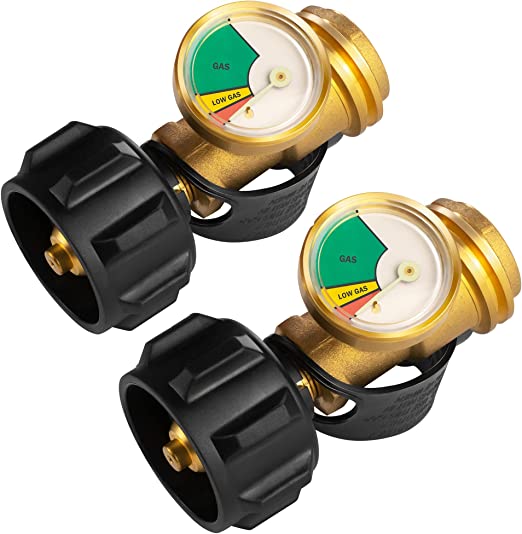
In our Scamp trailer, we depend on propane for cooking, warm showers and heat in the winter months. With how important those things are to us, being able to keep an eye on our propane levels is a must. These simple Propane Tank Gauges couldn’t be easier to install and keep an eye on. Never get caught without hot water!
Pros:
- Simple screw-on install
- Easy to read
- Includes two gauges
- Install it and leave it
- High quality
Cons:
- Only really gives you a rough idea of your levels (don’t expect exact accuracy)
You can purchase these propane gauges through Amazon here.
Bluetooth Battery Monitor
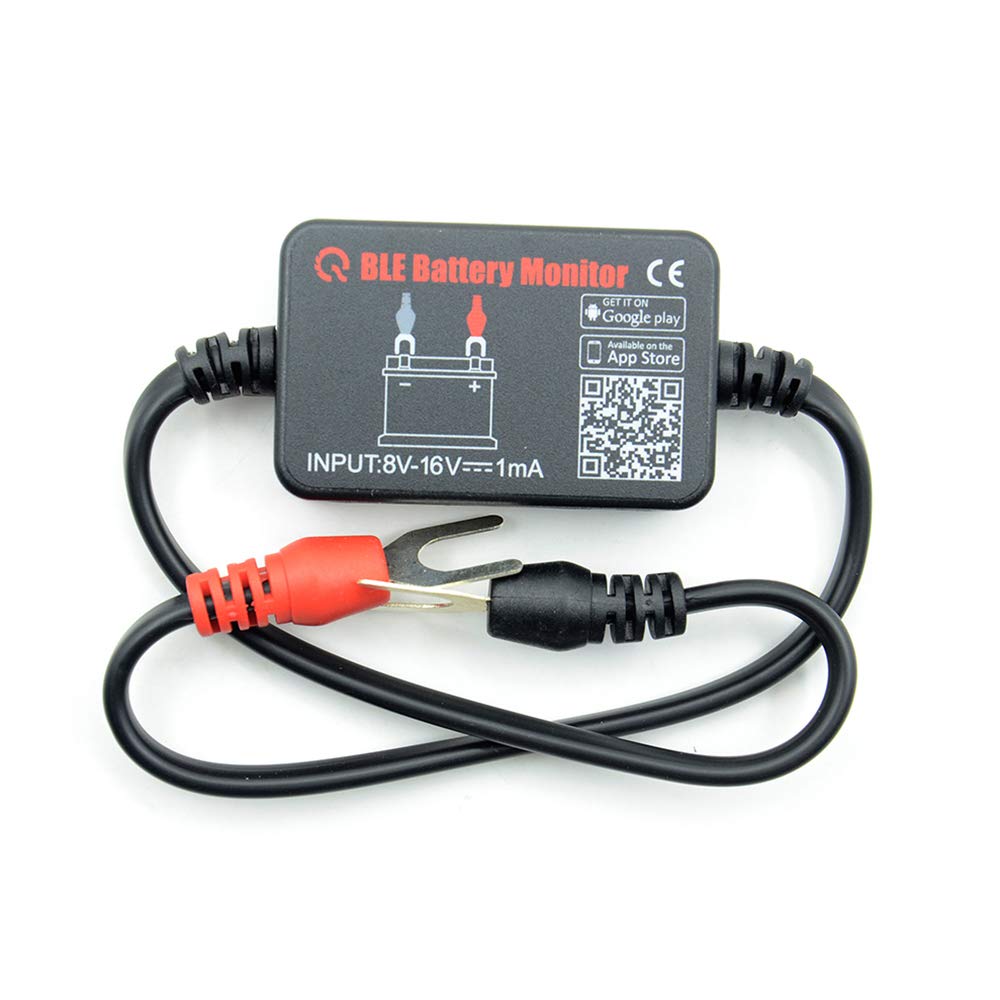
We charge our Scamp trailer with an inverter generator, but staying in some State and National Parks, there are “quiet hours” where we can’t use it. There’s nothing worse than realizing that your camper battery died while you’re in the middle of showering and can’t run your generator again to recharge. That’s where the Bluetooth Battery Monitor steps in. It allows us to keep an eye on the status of our camper battery 24/7 from our phones.
Pros:
- Easy to install
- Durable and weather safe (we’ve had it on through several storms)
- Install it and leave it (shouldn’t require taking it off or any maintenance)
- Simple and readable app
- Doesn’t require cell reception or WiFi
- Sends battery updates if it’s running low
Cons:
- Built for vehicles, so there are some unnecessary in-app features for campers
You can purchase the Bluetooth battery monitor on Amazon here.
The post 5 Essentials for Living Off-Grid in a Scamp Trailer first appeared on Old South Paw.
]]>